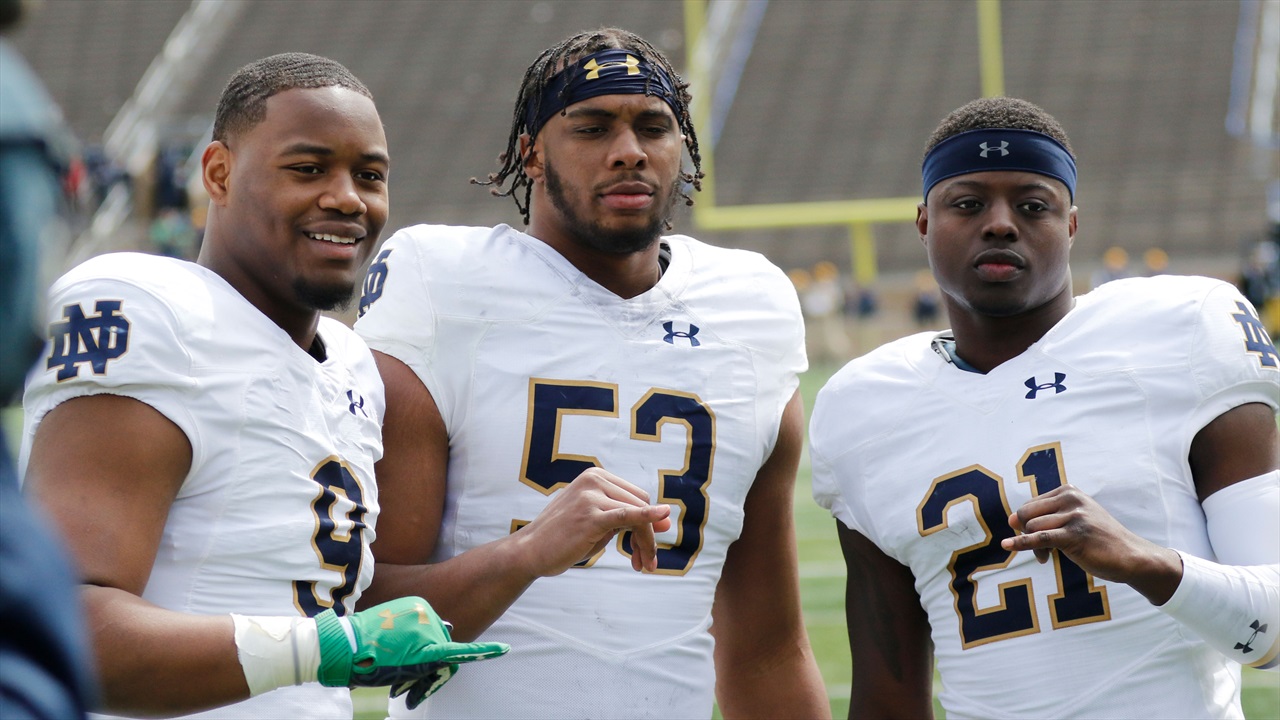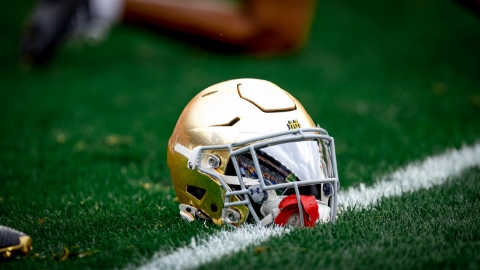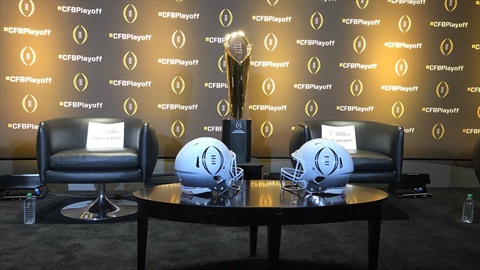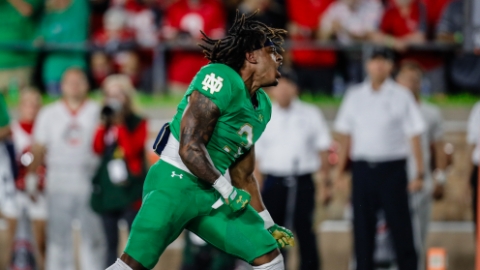
A lot of coaches on signing day have said they don’t care about recruiting rankings. Some of them definitely don’t and if the coach of (insert middle tier ACC program here) said it, I’d probably believe them.
They aren’t competing for the highest ranked recruits so they have to identify and evaluate differently than the top teams in the FBS. Their success also isn’t measured in national championships and maybe not even in a conference championship. They are judged on Ws and Ls like everyone else, but the bar is set lower depending on the program.
The bar is high at Notre Dame. The staff isn’t valuing individual recruits based on rankings, but they know that most of the players who are ranked in the top-50 and the ones who are ranked as 4 and 5-stars are generally better than the ones who aren’t. It’s at the very least another data point for them to look at to judge how well they are doing with a recruiting class.
Some of the reactions to Notre Dame’s class are a bit overblown. They have 21 commits and ⅔ of them are composite 4-star prospects. The average ranking per recruit is 90.61, which would be one of the better averages of the Brian Kelly era and that number is likely to go up.
No matter how they finish, this three year haul for Notre Dame under Marcus Freeman sets up the roster in 2024 to have more raw talent than any team Kelly had in his dozen years in South Bend.
That’s the big picture view of it all and I think that needs to be reiterated. That can be acknowledged while also recognizing that recruiting has dipped in the 2024 cycle compared to the last two years.
The composite average per recruit was 91.82 in 2022 and 91.78. And if you’re not a rankings person, we can just say that Notre Dame hasn’t landed as many of their top targets this cycle.
Last year they had a flurry of commitments from the recruits they had to close on after official visits in June. This year, that flurry isn’t happening. Even if they may not be out of it for elite prospects like Kyngstonn Viliamu-Asa, Bradley Shaw, Justin Scott, and Guerby Lambert, there is a lot of uncertainty of who they will or will not land as well as what direction they might go if they strike out with that group.
The biggest difference between this year’s class (at the moment) compared to last year’s is recruiting on the defensive side of the ball. With my grades for ISD, the average for the recruits they signed on defense in the last two cycles was 92. That’s down to 89.5.
There are still some very good prospects they have committed and I expect that at least a few of them I will end up giving higher grades to after their senior seasons, but 89.5 is in range with the averages I had for the defenders in the 2020 and 2021 cycles (89.9).
The 2020 class has produced only two full-time starters so far (a couple more should start this season) and the 2021 class has had only one player contribute (Gabriel Rubio) who is still on the roster this season.
The averages can change quite a bit if we see that Notre Dame has hit on some of these evals with lower ranked players and/or they end up landing a couple of those highly ranked targets who are still out there. They could also end up flipping a prospect or two that changes the dynamic of the group they are bringing in. (More on that later)
Notre Dame fans are hoping that happens, but it might not. And if it doesn’t, it isn’t a disaster like some might claim it is. It would be a disappointment, though.
The expectation was that Freeman was going to produce elite results in recruiting every year because the first two years backed that up. Notre Dame fans were hoping for even better results this cycle and the staff hasn’t delivered that at certain positions, at least not yet.
If the finish with this class ends up underwhelming, the important thing is for Freeman, Chad Bowden, and the staff as a whole to learn from it. A dip can turn into a decline and they can’t let that happen like it did too often with Kelly.
2. I think I’ve written “recruiting is a marathon, not a sprint” about 76 times in the last few years, but I keep mentioning it because it’s true. Rankings are fluid as are evaluations and the main thing that matters is the finish.
It also feels like a relevant time to mention that Cincinnati had 14 3-stars or lower drafted in the last three NFL Drafts and Notre Dame has had 13 total draft picks over that same time. Whether you want to point to them beating Notre Dame on the field in 2021 or comparing the NFL talent they’ve produced, they’ve been better at identifying, evaluating, and developing talent than Notre Dame.
They’ve had more players selected than Clemson, Oregon, USC, Miami, Texas, and Texas A&M as well. Cincinnati wasn’t landing anywhere close to the level or blue-chip recruits that any of these programs were and with so much Cincinnati influence on Notre Dame’s current staff, it should equate to at least some leve of patience and more trust with some of the lower ranked prospects they have committed in this cycle.
Should is the appropriate word because I know it won’t stop someone from saying “Well, this isn’t Cincinnati. This is Notre Dame” even though Cincinnati just proved that they could do it better than Notre Dame.
The counter to this would be that it was Luke Fickell’s program and it’s too early to determine if Freeman is the Kirby Smart to Fickell’s Nick Saban. That’s something we’ll be able to answer further down the road. Smart is the perfect example of process over results because they had a few ups and downs along the way before he got them to the mountain top in year six at Georgia.
3. Notre Dame’s most successful recruiting class in the last decade wasn’t the highest ranked one. The Irish signed 10 blue-chips out of 23 players in the 2016 class. The average ranking was 89 and it finished 15th in the class rankings.
Nine players ended up getting drafted, three others have been on 53-man rosters in the NFL, and the heart of that class was integral in both of Notre Dame’s undefeated regular seasons in 2018 and 2020.
The key to that class was Notre Dame ending up with previously committed prospects like Ian Book (Washington State), Khalid Kareem (Alabama), and Daelin Hayes (USC). Take those three players off of those teams and Kelly’s reboot becomes a failure.
Imagine the 2017 class without Jeremiah Owusu-Koramoah (Virginia) or the 2018 class without Jarrett Patterson (Arizona State). Think about this year’s Notre Dame team if they didn’t have Audric Estime (Michigan State) and it paints a bleak picture in the backfield.
We might be talking about Kenny Minchey (Pitt), Armel Mukam (Stanford), Christopher Terek (Wisconsin), and Kaleb Smith (Texas Tech) that way when looking back at the 2023 class. None of those players had been offered by Notre Dame at this time last year.
Can they flip a critical prospect over the next few months? I think they will because they were so aggressive trying to in the last cycle and I only see that ramping up with the way things have gone for them so far this summer.
4. I’ve been seeing a lot of Notre Dame fans recently talking about how Michigan is riding high right now in recruiting compared to the Irish and I’m not sure why that is.
Michigan's average recruit ranking is 90.62 right now. As mentioned above, ND's is 90.61. They have 15 blue-chips committed right now and Notre Dame has 14. The excitement around their recruiting feels like a reaction to them trending up (they signed 10 blue-chips in 2022 and 11 in 2023) compared to Notre Dame dipping (18 and 19 blue-chips respectively in the previous classes). Michigan’s blue-chip ratio is lower (62.5%) than Notre Dame’s as well.
It’s worth noting that three of those 4-star commits for Michigan are recruits that the Irish essentially passed on. Running back Jordan Marshall worked at Irish Invasion in the summer of 2022 and they ended up offering Aneyas Williams instead. Defensive linemen Owen Wafle “parted ways” with Notre Dame and Notre Dame prioritized other D-linemen over Jerod Smith as well.
I think anyone who follows the Irish would begrudgingly trade Michigan’s back to back to CFP appearances, wins over Ohio State, and their 14 NFL Draft picks (seven in the first three rounds) over the last two years with Notre Dame’s recent results, but right now they’ve turned that into recruiting at a level that most Notre Dame fans would consider disappointing.
They beat down their main rival and restored hope back into their program. They aren’t close to becoming a recruiting juggernaut.
5. Go back to the 2018 ISD Fab 50 and you can see I have only two defensive tackles who made the cut. Only one of them, Texas’ Keondre Coburn, ended up being drafted.
247Sports had four interior defensive linemen ranked in their top-50. None of them were drafted. Rivals had two and both weren’t drafted. ESPN had two and one of them, Nesta Jade Silvera, was drafted in the seventh round.
It was a weak class at the position.
I was looking back at it recently and couldn’t help but compare it to this current offensive tackle class. I have two offensive tackles in the current 2024 Fab 50. ESPN also has two. 247 has one. Rivals has two.
On3 has seven!
Since they launched a couple of years ago, they have ranked quarterback Devin Brown (Ohio State) as the number one prospect in the 2022 class when he wasn’t a top-30 prospect on any other site. They also ranked former Notre Dame linebacker Prince Kollie as a 5-star when no one else was close to doing so.
Edge James Pierce (Tennessee) was their 11th ranked prospect in 2022. No one else had him in the top-150. Quarterback Brady Allen (Purdue/Louisville) was in their top-50 when he was considered closer to 250 by the rest of the industry.
Even if I don’t agree with those rankings, I respect that they are clearly not being influenced by everyone else and have gone all-in with their own evaluations. They could very well end up being right with someone like offensive tackle Jonathan Daniels, who they have as their top offensive tackle in the country in the 2024 cycle. He’s incredibly raw, but he has elite tools.
These aren’t the final rankings so who knows how this is going to change by the time this class is finished, but I can’t see myself having seven offensive tackles in my final Fab 50. I know I would have regretted ranking seven defensive tackles in my top-50 in 2018. Only two of the top-10 in the composite rankings that year ended up being drafted and neither went on day one or day two of the NFL Draft.
6. Looking at how many top draft-eligible prospects are on a roster isn’t always an indicator of success. If it was, then Ohio State would have been a year away from success when they won a national championship in 2014.
That team was loaded with NFL talent, but most of their best players couldn’t leave for the NFL until after the 2015 season.
It is something I tend to look at with Notre Dame’s opponents heading into a season, though. More often than not, it’s the elite juniors and seniors who are the game wreckers that the Irish have to worry about each.
It’s pretty obvious that three teams the Irish are going to face this fall have more top draft-eligible talent than anyone else: USC, Clemson, and Ohio State. PFF did a rundown of top-10 draft prospects to watch at each position in college football and those teams were prominently featured.
For USC, they unsurprisingly have three potential high picks on offense. Draft twitter is working furiously trying to find a synonym for tanking that will work with Caleb Williams. Wide receiver Mario Williams and offensive tackle Jonah Monheim are the other two. The lone defender for them is safety Calen Bullock, who had five interceptions last season. (But skip his tackling display against Utah if you want to consider him a legitimate top prospect)
Clemson has running back Will Shipley and he’s the only one on offense for them. It says a lot about the situation that new offensive coordinator Garrett Riley is walking into that he doesn’t have that known quantity at wide receiver that they always had during their run which included two national championships.
It also says a lot that even though they lost two first round picks on the defensive line, they still have six players PFF listed from their defense: Defensive tackles Ruke Orhorhoro and Tyler Davis, linebackers Barrett Carter and Jeremiah Trotter, and safeties Andrew Mukuba and RJ Mickens. That strength up the middle didn’t help them stop Notre Dame from running Duo again and again against them, but Clemson’s defense should be the strength of their team in 2023.
Then there’s Ohio State. Oh, that pesky Ohio State.
They are loaded with top prospects, which is why those way-too-early mock drafts have them with several projected first round picks.
Marvin Harrison Jr. and Emeka Egbuka are the best receiving tandem in the country. Tight end Cade Stover is a threat and running backs TreVeyon Henderson and Miyan Williams are going to be tough to tackle. Williams averaged 4.36 yards per carry…after contact. Guard Donovan Jackson is one of the best in the country at his position as well.
They are equally talented on defense. Denzel Burke is an All-American candidate at corner, Tommy Eichenberg should be a Butkus Award contender at linebacker, and the defensive line is going to be a problem.
Defensive tackle Michael Hall Jr. already was against Notre Dame last season and Tyleik Williams (6’3” 318) is a monster. J.T. Tuimoloau and Jack Sawyer were two of the top-10 prospects in the entire 2021 recruiting class and Tuimoloau had 18 Havoc plays (tackles for loss, pass breakups, interceptions, and forced fumbles) last season.
That’s going to be a lot to handle for Notre Dame on both sides of the ball and although it’s nearly impossible to play perfect, it will require being close to that in order to beat the Buckeyes.
The Irish had three listed as draft-eligible players to watch by PFF. Sam Hartman was there as well as Joe Alt and Blake Fisher. They could use a few more names on those types of lists.
Every successful Notre Dame team has had players breakthrough as NFL prospects who weren’t considered to be before the season started. CJ Prosise, DeShone Kizer, and Tommy Tremble are some recent examples.
This year’s squad needs more than they have currently and they don’t necessarily have to be draft-eligible. They just have to show they will be prospects when they are because it’s going to be a lot more difficult to beat the best teams on their schedule if it doesn’t happen.
Men's League Collegiate Wear Navy Notre Dame Fighting Irish Guinness Stadium Pullover Hoodie




